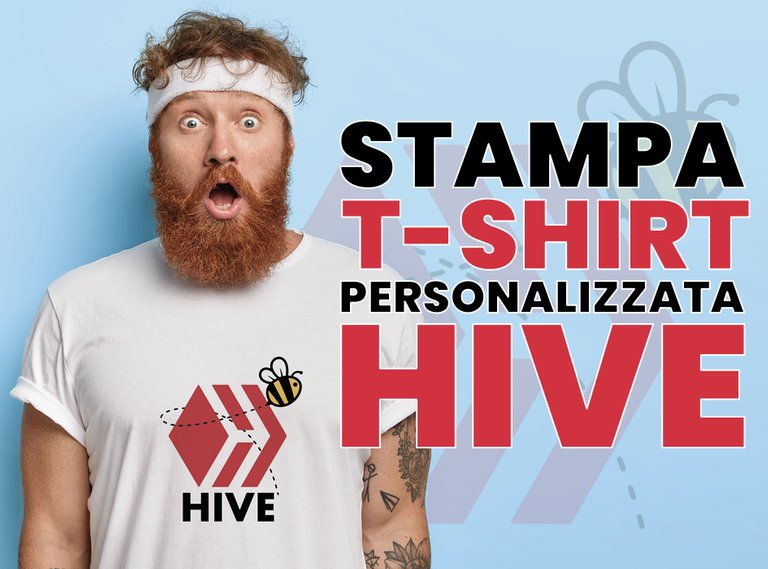
Bentrovati a tutti, con questo articolo voglio mostrarvi nello specifico, come viene personalizzata una T-shirt, tramite stampa serigrafica.
Come ho già detto altre volte, in questo periodo è nata la mia passione verso HIVE ed il suo ecosistema, così ho voluto omaggiare questa cosa realizzando un T-shirt a tema HIVE.
Quando si va a personalizzare una T-shirt esistono alcuni tipi di stampa differenti, infatti troviamo la tecnica delle applicazione termoadesive, la stampa digitale, la stampa sublimatica e la stampa serigrafica, ogni tecnica ha i suoi pro e i suoi contro, se la cosa vi interessa in futuro potrei mostrarvi anche le altre tecniche di stampa.
Che cosa è la stampa serigrafica e come funziona?
La stampa serigrafica è una tecnica di stampa di tipo permeografico che si avvale di un telaio di tessuto in nylon teso su un riquadro di alluminio o legno, il quale viene ricoperto da una gelatina fotosensibile e successivamente impresso tramite lampada UV, le parti impresse, tramite un lavaggio con acqua, verranno ripulite dalla gelatina, permettendo alla vernice di passare. Questa tecnica di stampa ha una lunghissima durata e resistenza, tra le varie tecniche di stampa è sicuramente quella più artistica.
Suddividerò questo articolo nelle seguenti fasi:
- Creazione grafica
- Impostazione grafica e stampa delle pellicole
- Preparazione e incisione del cliché
- Preparazione macchina
- Stampa
Creazione grafica
Durante la fase di progettazione grafica ho tenuto conto di 2 fattori, realizzare un disegno a tinte piatte, realizzare un disegno che fosse a tre colori, questo per contenere i costi, infatti ogni colore corrisponde a una pellicola e un cliché (impianto stampa) i quali hanno un costo di realizzazione che si aggira intorno i € 25,00/30,00 ad impianto stampa. Tenendo conto di questi fattori ho realizzato la grafica che vedete qui di seguito. Una grafica che omaggia HIVE.
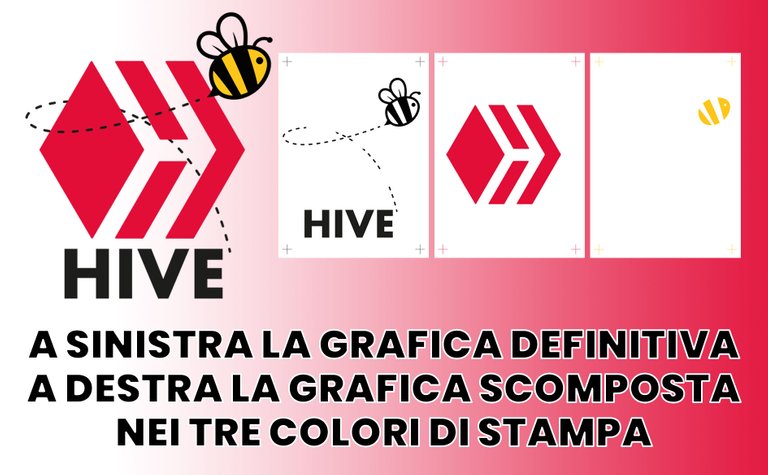
Una volta definita la grafica, sono andato a scomporre il disegno in tre livelli, ogni livello corrisponde ad un colore, ogni colore corrisponderà ad una pellicola e successivamente in fase di stampa ad un cliché. Questo passaggio è fondamentale per creare le pellicole, i crocini attorno all’immagine sono i famosi “crocini di registro”, questi mi permetteranno di sovrapporre le varie stampate in modo perfetto.
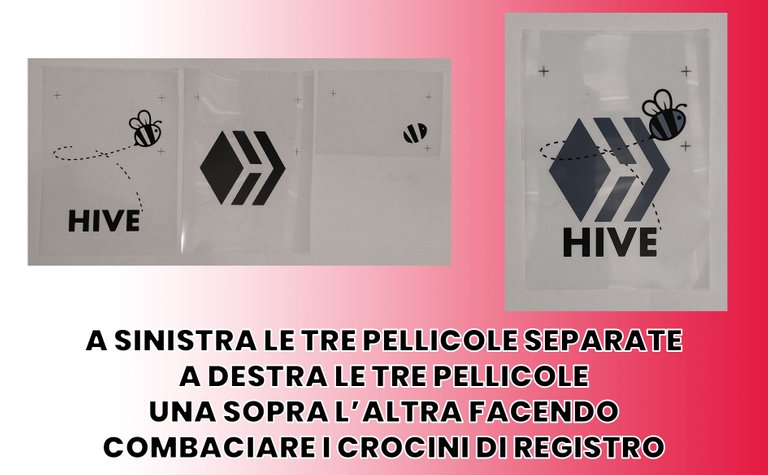
Preparazione e incisione del cliché
A questo punto bisogna preparare il cliché, come prima cosa verifico che il telaio sia pulito, una volta fatta questa verifica vado a ricoprire la superficie con una speciale gelatina fotosensibile, infatti l’intera operazione viene eseguita in una camera oscura. In questa fase è importante mettere un leggero strato di gelatina in modo omogeneo. Successivamente mettiamo il cliché in un apposito forno ad asciugare.

Quando la gelatina è asciutta, posiziono le pellicole sul telaio, bloccandole con del nastro adesivo trasparente. Fatto questo, posiziono il telaio in un bromografo, strumento che permette l’impressione del telaio tramite una potente luce UV. Questa operazione dura circa 100 secondi, in questo lasso ti tempo la luce andrà attivare un processo di fotoincisione, detto in modo estremamente semplice, le parti non coperte dalla pellicola verranno “seccate” (resistendo al successivo lavaggio), mentre le parti di gelatina coperte dalla pellicola, non essendo state esposte alla luce, verranno lavate via.
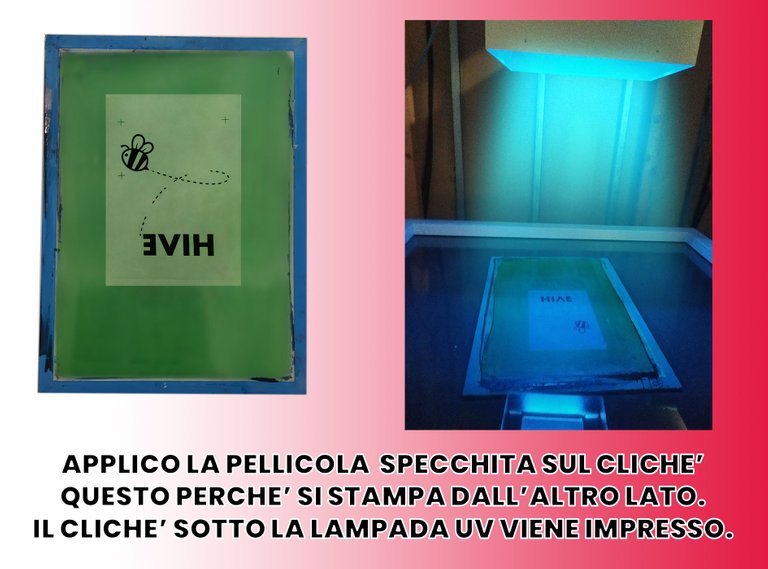
A questo punto rimuovo le pellicole dai telai e li vado a lavare, questo passaggio andrà ad eliminare le parti di gelatina che erano coperte dalla pellicola. Rimetto il cliché in forno per qualche minuto per una rapida asciugatura, ed il cliché è pronto.
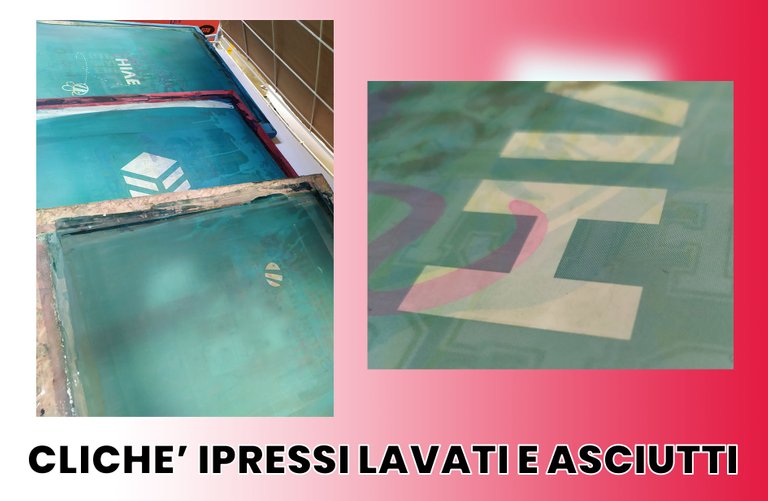
Preparazione macchina
Ora vado a impostare la macchina, come prima cosa inserisco un cliché per ogni braccio della giostra (la giostra è la macchina da stampa). Una volta inseriti tutti e tre, incollo una pellicola su un piano di stampa, questa mi servirà come riferimento per mettere a registro tutti e tre i cliché, così da avere un risultato di stampa perfetto.
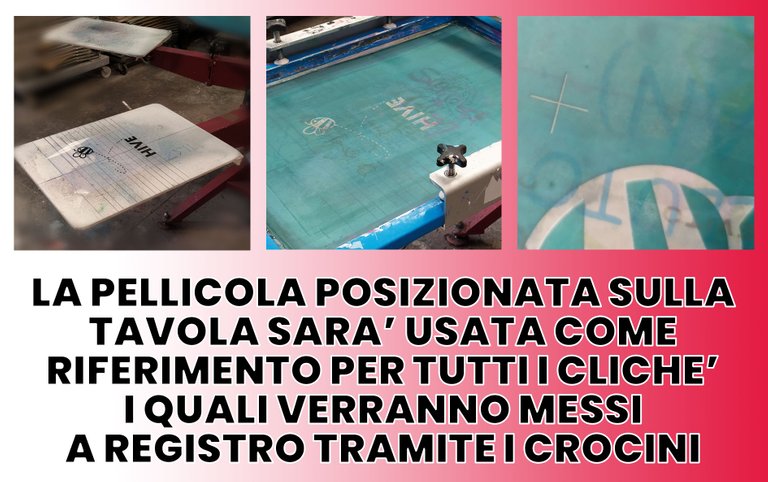
Fatta questa fondamentale operazione di precisione, vado a sigillare con del nastro adesivo i crocini, così in fase di stampa la vernice non potrà passare da questi. Come ultima cosa vado ad impostare la lampada asciugatrice, andando a dettare i parametri di potenza, velocità e spazio di movimento.
Stampa
Prima di iniziare con la stampa diluisco le vernici scelte con un pò di acqua e catalizzatore, questo rende la vernice più liquida quindi più penetrante nel tessuto e così da avere una stampa più duratura nel tempo. Una volta scelte le tre racle (strumento con cui stampare, la scelta viene fatta considerando la dimensione della stampa) si può iniziare a stampare.
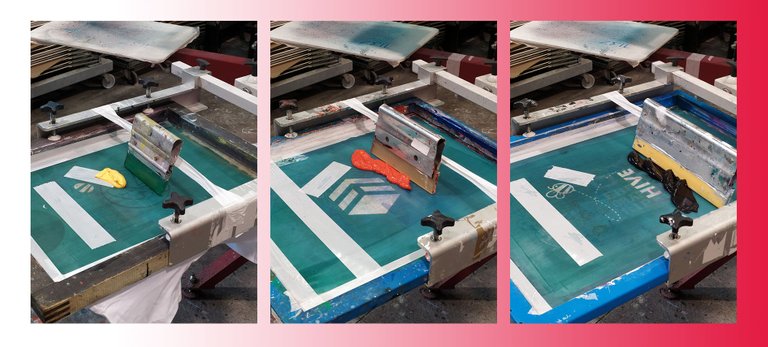
La giostra ha sei bracci quindi inserisco sei T-shirt neutre, la stampa seguirà il seguente schema di lavoro:
- Primo colore stampato GIALLO x 6
- Asciugatura colore GIALLO x 6
- Secondo colore stampato ROSSO x 6
- Asciugatura colore ROSSO x 6
- Terzo colore stampato NERO x 6
- Asciugatura colore NERO x 6
Nel seguente video possiamo vedere il processo di stampa.
Dopo circa 24h di riposo le nostre T-shirt personalizzate sono pronte per essere indossate.
Con questo articolo spero di avervi fatto conoscere questa tecnica di stampa molto affascinante.
Le t-shirt realizzate sono 6, quindi se qualcuno fosse interessato ad averne una me lo faccia sapere, così provvederò a fargliela recapitare, chiedo in cambio un'offerta in HIVE della somma che reputate opportuna, almeno per ripagare le spese di spedizione.
Potete contattarmi in privato o qui sotto nei commenti.
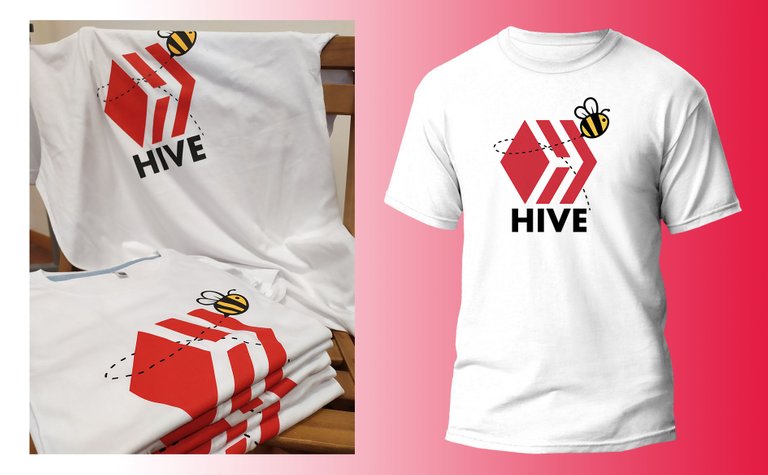
**ENGLISH VERSION
**
Welcome to everyone, with this article I want to show you specifically, how a T-shirt is personalized, using screen printing.
As I have said other times, in this period my passion for HIVE and its ecosystem was born, so I wanted to pay homage to this thing by making a HIVE themed T-shirt.
When you go to customize a T-shirt there are some different types of printing, in fact we find the technique of thermoadhesive applications, digital printing, sublimation printing and screen printing, each technique has its pros and cons, if the thing is there interested in the future I could also show you the other printing techniques.
** What is screen printing and how does it work? **
Screen printing is a permeographic printing technique that uses a nylon fabric frame stretched on an aluminum or wood panel, which is covered with a photosensitive gelatin and subsequently imprinted by means of a UV lamp, the impressed parts, through a wash with water, they will be cleaned of the gelatin, allowing the paint to pass. This printing technique has a very long duration and resistance, among the various printing techniques it is certainly the most artistic.
I will break this article down into the following stages:
- Graphic creation
- Graphic setting and printing of films
- Preparation and engraving of the cliché
- Machine preparation
- Printing
Graphic creation
During the graphic design phase I took into account 2 factors, creating a spot color design, creating a design that was in three colors, this to contain costs, in fact each color corresponds to a film and a cliché (printing system). which have a construction cost of around € 25.00 / 30.00 per printing system. Taking these factors into account, I created the graphics you see below. A graphic that pays homage to HIVE.
Once the graphics have been defined, I have broken down the drawing into three levels, each level corresponds to a color, each color will correspond to a film and subsequently, in the printing phase, to a cliché. This step is essential to create the films, the marks around the image are the famous "registration marks", these will allow me to superimpose the various prints in a perfect way.
Preparation and engraving of the cliché
At this point you need to prepare the cliché, first of all I check that the frame is clean, once this check is done I go to cover the surface with a special photosensitive gelatin, in fact the whole operation is performed in a dark room. At this stage it is important to apply a light layer of gelatin evenly. Then we put the cliché in a special oven to dry.
When the jelly is dry, I place the films on the frame, securing them with clear adhesive tape. Once this is done, I place the frame in a bromograph, a tool that allows the impression of the frame through a powerful UV light. This operation lasts about 100 seconds, during this time the light will activate a photoengraving process, said in an extremely simple way, the parts not covered by the film will be "dried" (resisting the subsequent washing), while the gelatine parts covered from the film, not having been exposed to light, will be washed off.
At this point I remove the films from the frames and I go to wash them, this step will eliminate the parts of gelatin that were covered by the film. I put the cliché back in the oven for a few minutes for a quick drying, and the cliché is ready.
Machine preparation
Now I'm going to set up the machine, first of all I insert a cliché for each arm of the carousel (the carousel is the printing machine). Once all three have been inserted, I glue a film on a printing surface, this will serve as a reference to register all three clichés, so as to have a perfect printing result.
Once this fundamental precision operation has been made, I go to seal the marks with adhesive tape, so during the printing phase the varnish will not be able to pass through them. Lastly I go to set the dryer lamp, going to dictate the parameters of power, speed and space of movement.
Printing
Before starting with the print I dilute the chosen paints with a little water and catalyst, this makes the paint more liquid therefore more penetrating into the fabric and so as to have a longer lasting print. Once you have chosen the three squeegees (tool with which to print, the choice is made considering the size of the print) you can start printing.
The carousel has six arms so I insert six neutral T-shirts, the print will follow the following working pattern:
- First printed color YELLOW x 6
- YELLOW drying x 6
- Second color printed RED x 6
- RED drying x 6
- Third color printed BLACK x 6
- BLACK color drying x 6
After about 24 hours of rest, our personalized T-shirts are ready to be worn.
With this article I hope to have introduced you to this very fascinating printing technique.
@tipu curate 2
Upvoted 👌 (Mana: 20/60) Liquid rewards.
Grazie @zottone444 .
di nulla ottimo post , condiviso anche su telegram
Gran bel lavoro! Magari ci mettiamo d’accordo pure per una t-shirt a tema OdB 👊🏻
!BEER
Ci starebbe un sacco... aggiorniamo un pò le grafiche di olio di balena e ci facciamo una bella maglietta.
Basterebbe il logo in realtà perché la grafica di copertina a me già piace così, pensavo ad una balena stilizzata che sbuffa mustakkio coins 😂
Magari @astrocreator può fare qualche bozza pure per questo.
Non sono un disegnatore e il rinnovo grafico è nella roadmap delle cose da fare, ma se qualcuno vuole cimentarsi e creare questo logo da zero io sono disponibile.
AHAHA ci starebbe la balena stilizzata i mustakkio coin non li ho mai visti quindi non so nemmeno come sia ahah
@fedesox certo, mi ci metto a lavoro volentieri.
Quando volete!!!😄... la mia disponibilità c'è...
Grazie @fedesox sono contenti che ti piaccia. Certo sarebbe fantastico creare una t-shirt a tema OcB. Quando vuoi.
View or trade
BEER.Hey @astrocreator, here is a little bit of
BEERfrom @fedesox for you. Enjoy it!Did you know that you can use BEER at dCity game to **buy dCity NFT cards** to rule the world.
Yay! 🤗
Your content has been boosted with Ecency Points, by @fedesox.
Use Ecency daily to boost your growth on platform!
Support Ecency
Vote for Proposal
Delegate HP and earn more
😁Grazie @fedesox !!!
Bravissimo @astrocreator sia per il post che per la realizzazione delle magliette
!BEER
!PIZZA
!LUV
@astrocreator! I sent you a slice of $PIZZA on behalf of @libertycrypto27.
Learn more about $PIZZA Token at hive.pizza (1/10)
Grazie @libertycrypto27 , felice che ti piaccia il lavoro fatto.
<><
@astrocreator, you've been given LUV from @libertycrypto27.
Check the LUV in your H-E wallet. (1/5)
Ottima iniziativa!
I wish to get myself one of this soon